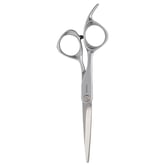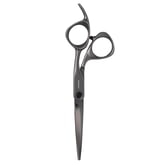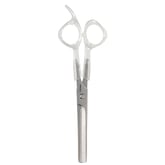Pro2Pro is an online resource center dedicated to enriching the careers of licensed beauty professionals.
How To Choose The Best Professional Hair Cutting Shears
The Complete Guide
To Professional
Hair Cutting Shears
As a salon professional, shears for cutting and styling are vital to your business. That’s why it’s important to know the basics about shears before you buy. You’ll want to think about the top options for your clients and budget. Do you want hairstyling shears in a traditional design or those with ergonomic features? Are you looking for the best shears backed by superior steel and elite workmanship? High quality shears are an investment that will help you cut smoothly and confidently for years to come.
Materials and Costs
Depending upon your budget and needs, you can choose between low-cost, moderately priced and premium shears. Fromm, a trusted partner to stylists since 1907, recently launched Shear Artistry, a new line of shears that offers beautiful design and best-in-class performance at each price point.
Premium Shears
- Often handmade, starting at around $200
- Crafted as an investment in Germany from German steel
- May also be crafted from Japanese steel
- Made from high quality steel for longer life and less frequent servicing
Moderately Priced Shears
- In a price range from $60 to $200
- Usually made from German or another high quality steel
- Commonly crafted in Asia or Pakistan
- Dependable and longer lasting when made of quality steel
Low-Cost Shears
- Priced in the $10 to $60 range
- Machine-manufactured with lower quality steel
- Have a lower grade of workmanship
- Last about three months with regular use
It’s important to know that low-cost shears with a serrated-edge blade are machine-sharpened during manufacturing. They cannot be sharpened after purchase and will eventually wear out.
The quality of a pair of shears is affected by the steel used to manufacture the blades. Germany and Japan are two countries offering a higher grade of steel for making the three main types of blades - convex, semi-convex and beveled. Convex blades support your advanced techniques with smoother, sharper cutting. Semi-convex blades offer durability, while beveled edge blades are an older design, which is often found on less expensive shears.
Convex
- Has a slight curve on the blade edge that forms an angle
- Also called a Japanese style blade
- Requires more care than other blade types
- Comes with a very sharp edge
- Supports advanced cuts, finishing cuts and chipping
Semi-Convex
- A combination of convex and beveled edge blades
- Features a narrower beveled edge with a slight curve
- Sharper and more durable than a beveled edge blade
Beveled Edge
- Cuts well but requires more force than a convex blade
- Offers a flat-surface cutting edge
- Durable due to its edge thickness
- Not designed for advanced techniques, such as slide cutting
Blade Lengths
Select a blade length that coordinates with the length of your hand, the technique you’ll be performing, and your desired level of control. A shorter blade could support fine, precision cutting with greater control, while a longer blade could cut hair more efficiently. Many professionals own shears with different blade lengths to meet varying needs.- Blade lengths range from 4 to 7 inches.
- Shorter blades of up to 5.5 inches are often used for intricate cuts, touchups or cutting close to the skin.
- Longer blades are preferred for bobbed cuts, slide cutting, scissor-over-comb styling and cutting thick hair.
- A 5.5-inch blade is commonly used in beauty schools.
Handles and Features
Keep in mind a handle with an ergonomic design, like the Fromm Defy and Invent shears, can benefit both your technique and comfort. Since your thumb plays a major role in cutting, shears with a thumb rest also reduce fatigue as you perform repetitive movements. And for quieter cutting, bumpers can be placed on the shears.
- Also known as opposing handle or opposing grip
- The oldest style of handle
- Not an ergonomic design
- Most popular type
- Ergonomically designed to reduce fatigue
- Includes the crane-style design
- Standard or flat
- Removable
- Angled
- Swivel - offers the most natural thumb positioning
- Placed between the finger rests
- Designed to protect and silence shears
- Removable and replaceable
Caring for Your Shears
Salon shears will last longer and perform to expectations when you follow a maintenance routine that includes daily cleaning. You can also protect your shears by placing them in a closed position on a towel as you style
DON’T CUT these with shears:
- Paper, nylon, plastic or other materials
- Hair that has a treatment in it, such as perm solution
- Hair that has product in it, like hairspray
Routine Maintenance
In addition to following manufacturer’s instructions, here are some tips to remember:
- Check the tension periodically.
- Store in the closed position in the case.
- Don’t place on or near objects that could damage the blades.
- Each week, place a drop of oil on a blade, then open and close the shears several times. Wipe away any excess oil with a soft cloth.
Cleaning Options
As a first step in cleaning, carefully remove all the hair from the shears. Next, choose a cleaning method:
- Pour 2 oz (1/4 cup) of Barbicide concentrate into 32oz (4 cups) of cold water
- Implements and surface must stay moist with Barbicide for 10 full minutes
- Clean with Clippercide spray.
- Use a heated sanitizer for cleaning.
Shield Shears
Protect your shears by knowing how damage occurs. For example, when blades are exposed to hair styling products, corrosion can occur. Even soaking your shears in a liquid for more than 10 minutes could cause damage. Try to avoid accidental drops, and only use your shears to cut wet or dry hair. Be sure to review the care guidelines that come with your tool.
Blade Sharpening for Shears
You should have your shears professionally sharpened at least once a year, though the amount of cutting you do will determine how often they need sharpening. It’s a good idea to check your shears every three months to see if sharpening is required. When it’s time for service, choose a professional affiliated with a reputable company. Sharpening is a specialized craft, and one bad job could damage your tool.
Specialty Shears
In addition to haircutting shears, you probably want specialty shears for styling. Thinning and texturizing shears are specialty tools that have a serrated-edge blade for specific results.
Thinning Shears
- Also called blending shears
- Featuring blade teeth separated by small spaces
- Used to add texture to hair or blend hair ends
- Can remove bulk from thick hair
Texturizing Shears
- Have wider spaces between blade teeth
- Create a noticeable effect
- Used to add lift to a style
A pair of quality shears for the salon can be a business asset that positively affects results and keeps your hand comfortable during a long day of cutting. If you’re choosing higher-end shears, make sure you get superior features plus ergonomic benefits. By learning more about these essential salon tools, you’ll be a smart buyer who’s happy with your business investment.
Did you find this article helpful?
At Marlo Beauty Supply, we're dedicated to helping licensed salon professionals succeed. Our Pro2Pro section is designed to offer advice and share news with industry insiders. If you're in the market, don't hesitate to check out our selection of quality and affordable professional shears, discounted for licensed beauty pros.
| SHOP: | www.marlobeauty.com |
| SHARE: |











